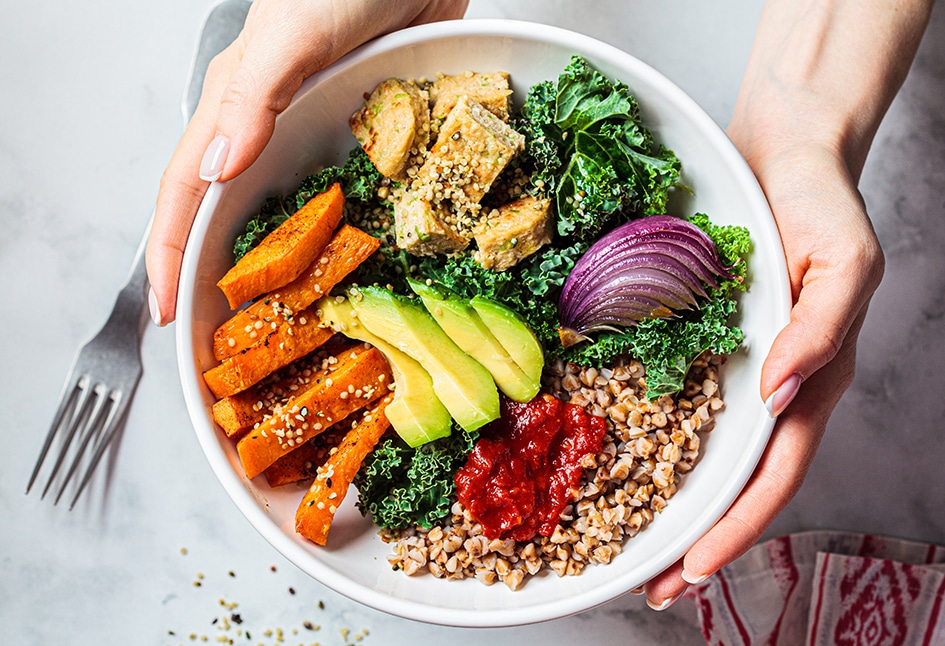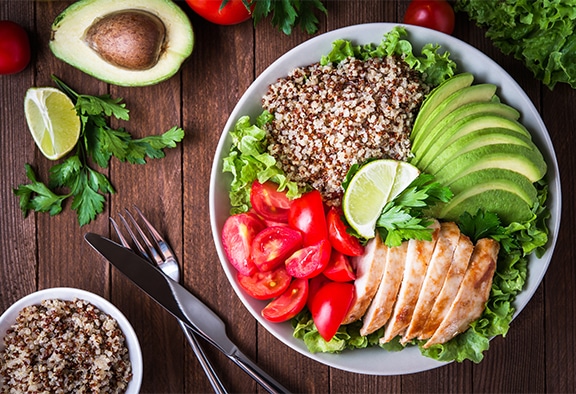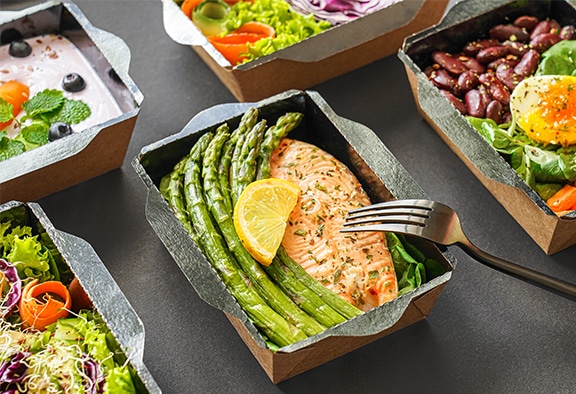
If you’re living with diabetes, good nutrition is essential. Here’s the ADS guide to diabetes nutrition—including the basics of building a healthy diabetes meal plan.

Written by: ADS Staff
Reviewed by: Halle Elbling, MS, RDN, CDCES
No one can afford to ignore their nutritional needs, but it is extra important for people living with diabetes. After all, this disease is defined by elevated blood glucose levels and risks of complications. Taking that into account, it’s easy to see why getting serious about your diabetes nutrition is a crucial step toward successful management.
Have you recently been diagnosed with diabetes? If so, you may be wondering what good nutrition for people living with diabetes actually looks like. On the other hand, even if you’ve had diabetes for a while, you might need a refresher on eating right. Either way, keep reading for ADS’ guide to type 1 and type 2 diabetes nutrition.
Understanding the Role of Nutrition in Managing Blood Sugar Levels
By definition, people with diabetes tend to have a harder time managing their blood glucose levels than the general population does. Carbohydrates in the foods and beverages you consume can have a huge effect on blood sugar levels. By emphasizing the right food groups and cutting out sweets and other “junk foods” as part of your strategy for diabetes and nutrition, you can seriously improve your glucose levels.
Of course, following the right diet won’t negate your need for exercise, insulin, and other diabetes management strategies. But whether you have type 1, type 2, or gestational diabetes, nutrition is an essential part of controlling this disease. And keeping your blood sugar in range isn’t just helpful in the short term—it can significantly reduce your chances of developing severe diabetes complications like heart disease and vision loss.
The Importance of Following a Balanced and Healthy Diet

Since everybody’s nutritional needs are different, there’s no fixed diabetes diet that’s ideal for every person with diabetes. But when you’re building a healthy meal plan that takes nutrition and diabetes into account, you’ll want to include foods from these categories:
Vegetables.
Veggies are a vital part of any nutritious diet, and that doesn’t change if you have diabetes. Fresh vegetables, greens (including kale and spinach), and steamed frozen vegetables are all low in salt and fat and high in fiber. Of course, that makes them perfect for people living with diabetes.
Fruits.
Like vegetables, fruits are packed with fiber, vitamins, and minerals. But compared to veggies, fruits contain more carbohydrates per serving on average. That doesn’t make them a bad choice when it comes to nutrition for diabetes, however. Just be sure to focus on eating fresh fruit and other fruit-based foods without added sugar.
Proteins.
If you have diabetes, you have all kinds of protein sources to choose from—but it’s essential to make wise choices in this category. That means you shouldn’t eat excessive amounts of processed and fatty meats like ribs, bacon, and pork chops. Instead, prioritize lean meats, poultry, fish, tofu, and plant-based proteins.
Whole grains.
Adding carbs to a diabetes diet can be tricky, but you shouldn’t exclude this category from your diet, either. It’s wise to focus on whole-grain carbohydrates like brown rice, whole-wheat pasta, and oatmeal.
Diabetes Nutrition: Common Challenges and How to Overcome Them
By following a balanced diet that includes the food groups listed above, you’ll be well on your way to eating right with diabetes. Of course, that isn’t the only nutritional challenge you’ll face while managing this condition. If you’re trying to eat right with diabetes, make a point of:

Getting the correct amount of carbs.
When you have diabetes, you need to consider both your everyday need for carbohydrates and the impact carbs can have on your blood sugar. Carb counting—that is, tracking the number of carbohydrates you consume in a day and adjusting your insulin dosage to match—can make this balancing act considerably easier.
Controlling your serving sizes.
If you’re trying to build a nutritious diabetes meal plan, eating the right types of food is just one piece of the puzzle. You’ll also need to find ideal portion sizes for your meals. Following the “plate method” is a simple, effective way to do just that.
Keeping sodium levels in check.
Blood glucose isn’t the only factor people with living with diabetes should consider while building a diabetes meal plan. Reducing your salt intake can help you avoid two notorious diabetes complications—namely, heart disease and hypertension.
Drinking alcohol safely (if at all).
Managing diabetes doesn’t mean you can’t safely enjoy alcohol in moderation. But be sure to eat something along with your drink of choice, as alcoholic beverages can lower your blood glucose on an empty stomach. And, of course, be sure to ask your healthcare team before drinking alcohol with diabetes.
Nutritional Drinks: What to Look for and What to Avoid
Losing weight is a great way to manage diabetes. With that in mind, you might be curious about whether or not you can drink meal replacement shakes if you have this condition. Nutritional drinks for people living with diabetes can be a smart choice in some situations, especially when cooking or buying a diabetes-friendly meal would be difficult. Despite this, there are a few things you should know before adding these beverages to your diet.
While nutritional drinks can certainly fill in for the odd meal, they can’t deliver all the dietary nutrition you need in a day. Many weight loss shakes are also high in calories, and sugar which could actually make it harder for you to lose weight and affect your glucose levels. And while these drinks are packed with protein, the average adult only needs between 46 and 56 grams of protein daily.
Thus, it’s best to combine occasional nutritional drinks with a diabetes diet that is focused on whole foods. When you do buy shakes, be sure they’re formulated with the goal of providing nutrition for diabetes and don’t include sugar or high fructose corn syrup among the first three ingredients.
Manage Diabetes with Nutrition—And Supplies from ADS
Living with diabetes isn’t always easy, but eating right is one of the most important things you can do to keep this disease under control. By following the advice included in this article, you’ll be able to eat a balanced diet and face the challenges that come with nutrition for people living with diabetes.
While you’re at it, it’s wise to re-evaluate other aspects of your approach to diabetes management—including where you get diabetes supplies. If you choose the wrong diabetes supplier, you could find yourself waiting for crucial packages to arrive and putting up with subpar customer service. The most effective way to avoid these issues is to order supplies online from ADS today!
